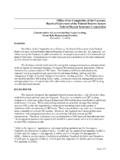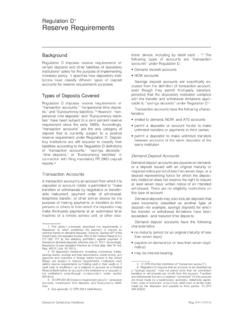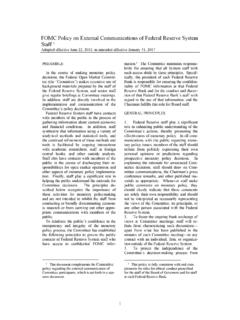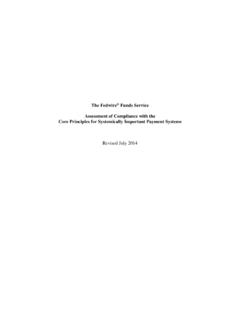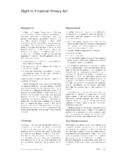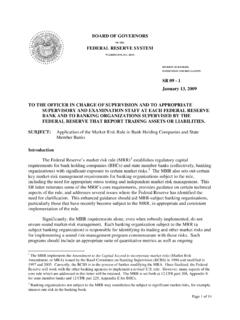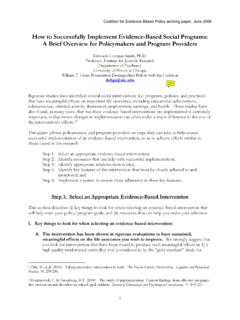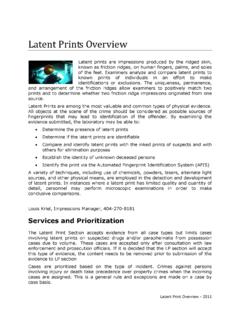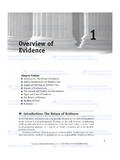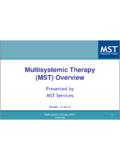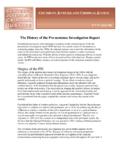Transcription of and Overview - Federal Reserve System
1 Note: This Overview is adapted from the introduction to the Interagency fair lending Examination Procedures, which were revised in 2004 and distributed by the Board as an attachment to CA Letter 04-8. 1. HUD s regulations are at 24 CFR 100. Federal fair lending regulations and statutes Overview The Federal fair lending laws the Equal Credit Opportunity Act and the fair Housing Act prohibit discrimination in credit transactions, including transactions related to residential real estate. The statutes and Implementing regulations The Equal Credit Opportunity Act (ECOA), which is implemented by the Board s Regulation B (12 CFR 202), prohibits discrimination in any aspect of a credit transaction. It applies to any extension of credit, including residential real estate lending and extensions of credit to small businesses, corpora tions, partnerships, and trusts. The ECOA prohibits discrimination based on Race or color Religion National origin Sex Marital status Age (provided the applicant has the capacity to contract) The applicant s receipt of income derived from any public assistance program The applicant s exercise, in good faith, of any right under the Consumer Credit Protection Act lending acts and practices that are specifically prohibited, permitted, or required are described in the regulation.
2 Official staff interpretations of the regulation are contained in supplement I to the regulation. The fair Housing Act (FHAct), which is imple mented by HUD regulations ,1 prohibits discrimina tion in all aspects of residential real estate related transactions, including, but not limited to, Making loans to buy, build, repair, or improve a dwelling Purchasing real estate loans Selling, brokering, or appraising residential real estate Selling or renting a dwelling The FHAct prohibits discrimination based on Consumer Compliance Handbook fair lending : Overview 1 (1/06) Race or color Religion National origin Sex Familial status (that is, discrimination against households having children under the age of 18 living with a parent or legal custodian, pregnant women, or persons with legal custody of children under 18) Handicap Because both the FHAct and the ECOA apply to mortgage lending , lenders may not discriminate in mortgage lending on the basis of any of the prohibited factors listed.
3 In addition, with respect to residential real estate related lending , under both laws, a lender may not, on the basis of a prohibited factor, Fail to provide information or services relating to, or provide different information or services relating to, any aspect of the lending process, including credit availability, application proce dures, and lending standards Discourage or selectively encourage applicants with respect to inquiries about or applications for credit Refuse to extend credit, or use different stan dards in determining whether to extend credit Vary the terms of credit offered, including the amount, interest rate, duration, and type of loan Use different standards to evaluate collateral Treat a borrower differently in servicing a loan or invoking default remedies Use different standards for pooling or packaging a loan in the secondary market A lender may not express, orally or in writing, a preference that is based on a prohibited factor or indicate that it will treat applicants differently on the basis of a prohibited factor.
4 Moreover, a lender may not discriminate on a prohibited basis because of the characteristics of An applicant, prospective applicant, or borrower A person associated with an applicant, prospec tive applicant, or borrower (for example, a co-applicant, spouse, business partner, or live-in aide) The present or prospective occupants of either the property to be financed or the neighborhood or other area in which the property to be financed is located Federal fair lending regulations and statutes : Overview Finally, the FHAct requires lenders to make reasonable accommodations for a person with disabilities when such accommodations are neces sary to afford the person an equal opportunity to apply for credit. Types of lending Discrimination The courts have recognized three types of proof of lending discrimination under the ECOA and the FHAct: Overt evidence of disparate treatment Comparative evidence of disparate treatment Evidence of disparate impact Disparate Treatment The existence of illegal disparate treatment may be established either by statements revealing that a lender explicitly considered prohibited factors (overt evidence) or by differences in treatment that are not fully explained by legitimate nondiscrimina tory factors (comparative evidence).
5 Overt Evidence of Disparate Treatment Overt evidence of discrimination exists when a lender openly discriminates on a prohibited basis. Example. A lender offers a credit card with a limit of up to $750 for applicants age 21 30 and $1,500 for applicants over 30. This policy violates the ECOA s prohibition on discrimination on the basis of age. Overt evidence of discrimination also exists even when a lender expresses but does not act on a discriminatory preference. Example. A lending officer tells a customer, We do not like to make home mortgages to Native Americans, but the law says we may not discriminate and we have to comply with the law. This statement violates the FHAct s prohi bition against statements expressing a discrimi natory preference as well as section (a) of Regulation B, which prohibits discouraging appli cants on a prohibited basis. Comparative Evidence of Disparate Treatment Disparate treatment occurs when a lender treats a credit applicant differently on the basis of one of the prohibited factors.
6 Showing that, beyond the differ ence in treatment, the treatment was motivated by prejudice or by conscious intention to discriminate against a person is not required. Different treatment is considered by courts to be intentional discrimi 2 (1/06) fair lending : Overview Consumer Compliance Handbook nation because the difference in treatment on a prohibited basis has no credible, nondiscriminatory explanation. Disparate treatment may be more likely to occur in the treatment of applicants who are neither clearly well qualified nor clearly unqualified. Dis crimination may more readily affect applicants in this middle group for two reasons. First, applica tions that are close cases have more room and need for lender discretion. Second, whether or not an applicant qualifies may depend on the level of assistance provided by the lender in completing an application. The lender may, for example, propose solutions to credit or other problems relevant to an application, identify compensating factors, and provide encouragement to the applicant.
7 Lenders are under no obligation to provide such assistance, but to the extent that they do, the assistance must be provided in a nondiscriminatory way. Example. A nonminority couple applies for an automobile loan. The lender finds adverse infor mation in the couple s credit report. The lender discusses the credit report with the couple and determines that the adverse information, a judg ment against the couple, was incorrect, as the judgment had been vacated. The nonminority couple was granted a loan. A minority couple applied for a similar loan with the same lender. Upon discovering adverse information in the minority couple s credit report, the lender denies the loan application on the basis of the adverse information without giving the couple an oppor tunity to discuss the report. The foregoing is an example of disparate treat ment of similarly situated applicants apparently on the basis of a prohibited factor in the amount of assistance and information provided.
8 If a lender has apparently treated similar appli cants differently on the basis of a prohibited factor, it must explain the difference. If the explanation is found to be not credible, the Federal Reserve may conclude that the lender intentionally discrimi nated. Redlining is a form of illegal disparate treatment whereby a lender provides unequal access to credit, or unequal terms of credit, because of the race, color, national origin, or other prohibited characteristic(s) of the residents of the area in which the credit seeker resides or will reside or in which the residential property to be mortgaged is located. Redlining may violate both the FHAct and the ECOA. Disparate Impact A disparate impact occurs when a lender applies a racially (or otherwise) neutral policy or practice Federal fair lending regulations and statutes : Overview equally to all credit applicants but the policy or practice disproportionately excludes or burdens certain persons on a prohibited basis.
9 Example. A lender s policy is to deny loan applications for single-family residences for less than $60,000. The policy has been in effect for ten years. This minimum loan amount policy is shown to disproportionately exclude potential minority applicants from consideration because of their income levels or the value of the houses in the areas in which they live. Although the law on disparate impact as it applies to lending discrimination continues to develop, it has been clearly established that a policy or practice that creates a disparity on a prohibited basis is not, by itself, proof of a violation. When an examiner finds that a lender s policy or practice has a disparate impact, the next step is to determine whether the policy or practice is justified by business necessity. The justification must be manifest and may not be hypothetical or specula-tive. Factors that may be relevant to the justification include cost and profitability.
10 But even if a policy or practice that has a disparate impact on a prohib ited basis can be justified by business necessity, it may still be found to be in violation if an alternative policy or practice could serve the same purpose with less discriminatory effect. Finally, evidence of discriminatory intent is not necessary to establish that a lender s adoption or implementation of a policy or practice that has a disparate impact is in violation of the FHAct or the ECOA. Consumer Compliance Handbook fair lending : Overview 3 (1/06)
